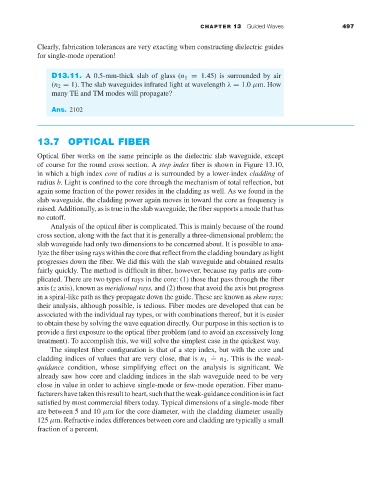Page 515 - Engineering Electromagnetics, 8th Edition
P. 515
CHAPTER 13 Guided Waves 497
Clearly, fabrication tolerances are very exacting when constructing dielectric guides
for single-mode operation!
D13.11. A 0.5-mm-thick slab of glass (n 1 = 1.45) is surrounded by air
(n 2 = 1). The slab waveguides infrared light at wavelength λ = 1.0 µm. How
many TE and TM modes will propagate?
Ans. 2102
13.7 OPTICAL FIBER
Optical fiber works on the same principle as the dielectric slab waveguide, except
of course for the round cross section. A step index fiber is shown in Figure 13.10,
in which a high index core of radius a is surrounded by a lower-index cladding of
radius b. Light is confined to the core through the mechanism of total reflection, but
again some fraction of the power resides in the cladding as well. As we found in the
slab waveguide, the cladding power again moves in toward the core as frequency is
raised. Additionally, as is true in the slab waveguide, the fiber supports a mode that has
no cutoff.
Analysis of the optical fiber is complicated. This is mainly because of the round
cross section, along with the fact that it is generally a three-dimensional problem; the
slab waveguide had only two dimensions to be concerned about. It is possible to ana-
lyze the fiber using rays within the core that reflect from the cladding boundary as light
progresses down the fiber. We did this with the slab waveguide and obtained results
fairly quickly. The method is difficult in fiber, however, because ray paths are com-
plicated. There are two types of rays in the core: (1) those that pass through the fiber
axis (z axis), known as meridional rays, and (2) those that avoid the axis but progress
in a spiral-like path as they propagate down the guide. These are known as skew rays;
their analysis, although possible, is tedious. Fiber modes are developed that can be
associated with the individual ray types, or with combinations thereof, but it is easier
to obtain these by solving the wave equation directly. Our purpose in this section is to
provide a first exposure to the optical fiber problem (and to avoid an excessively long
treatment). To accomplish this, we will solve the simplest case in the quickest way.
The simplest fiber configuration is that of a step index, but with the core and
.
cladding indices of values that are very close, that is n 1 = n 2 . This is the weak-
quidance condition, whose simplifying effect on the analysis is significant. We
already saw how core and cladding indices in the slab waveguide need to be very
close in value in order to achieve single-mode or few-mode operation. Fiber manu-
facturershavetakenthisresulttoheart,suchthattheweak-guidanceconditionisinfact
satisfied by most commercial fibers today. Typical dimensions of a single-mode fiber
are between 5 and 10 µm for the core diameter, with the cladding diameter usually
125 µm. Refractive index differences between core and cladding are typically a small
fraction of a percent.

